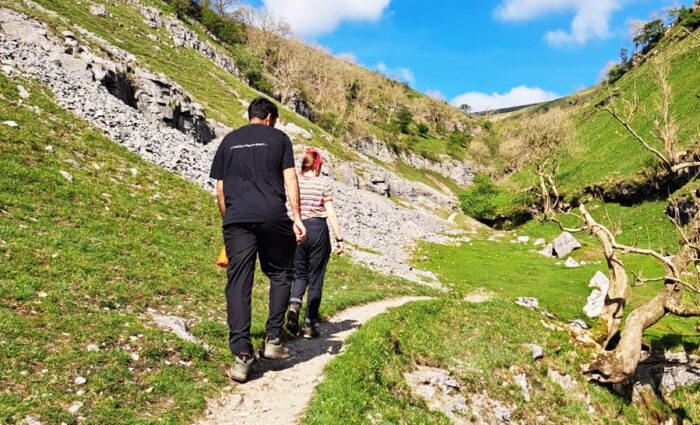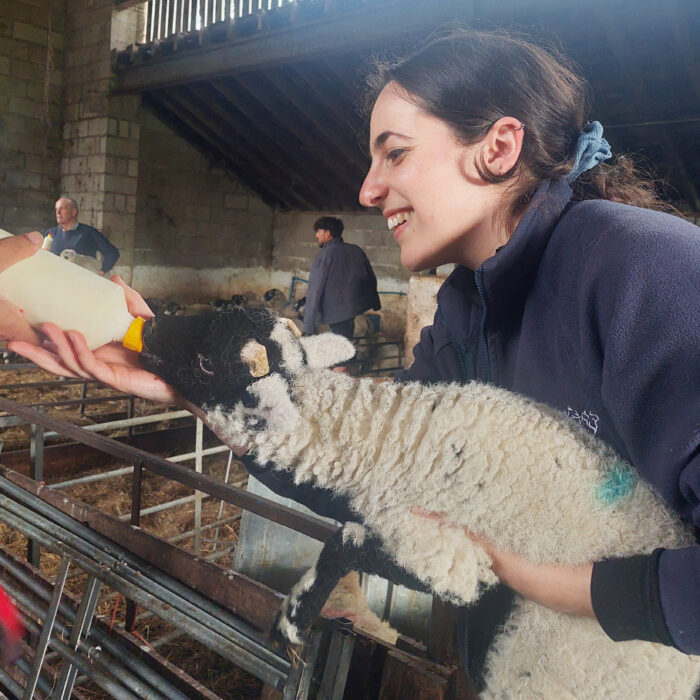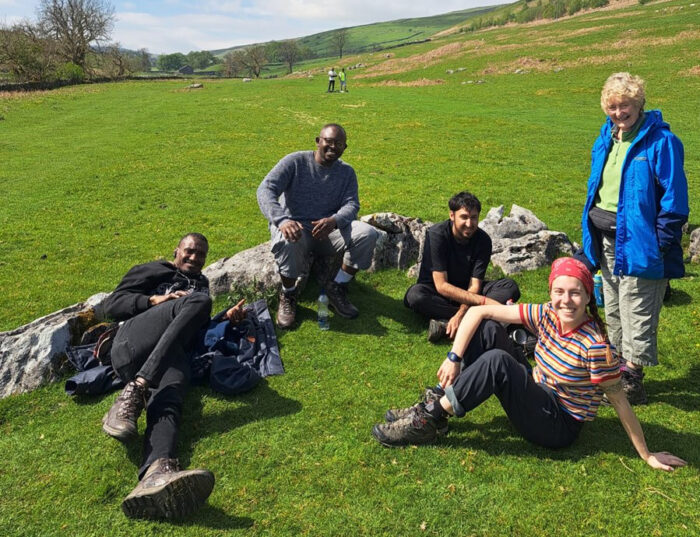Asylum seekers find peace and protection in the Yorkshire Dales
June 14, 2024
Aila Taylor recently joined YDMT as a Woodland Trainee. In her blog she tells us about her hopes for improving accessibility to the Yorkshire Dales for everyone, and how YDMT helps asylum seekers and others to do just that through our People and the DALES outreach programme.
The Yorkshire Dales – a home for travellers far and wide
Every year, there is a particular day in spring where the sun shines on the Yorkshire Dales for what feels like the very first time. A day where cold is replaced by warmth, grey skies are painted blue, and winter’s gloom blooms into puffy white clouds of hope. Today is that day.

For the young men piling out of a minibus at Yockenthwaite, it is also their first visit to the Dales. They are asylum seekers from Sudan and Afghanistan, here to explore the countryside, enjoy the fresh air and learn about Dales farming. We meet beneath a blossoming rowan, which is known as the tree of protection in traditional British and Scandinavian folklore. Previous inhabitants of the hamlet would have recognised it as such. When I moved to the Dales a mere eight months ago in search of peace and protection, I found them both here, in the snaking ghylls, shimmering waterfalls and sweeping moors. It is my hope that by improving accessibility to the Dales (and outdoor spaces in general), we might help others find peace and protection here too.
Exploring Yockenthwaite
Though small in size, Yockenthwaite is large in character. A picturesque cluster of old farm buildings nestled in the heart of Langstrothdale. The land rises steeply on either side, where scraggly hawthorns, crumbling drystone walls and vertical limestone scars all blend into a three-dimensional mosaic. No matter how many times I visit, there is always more to do. More to see. More to learn.
We cross an eighteenth century bridge over the river and meet the farmer, whose family have lived and worked here for over a century. But the history of Yockenthwaite is far older than that. Its name means ‘Yoghan’s clearing’ and has early medieval origins, indicating that the place has been inhabited for over a thousand years. ‘Yoghan’ is an Old Norse adaptation of the Old Irish ‘Eogan’, a blending of cultures that is embedded at the very core of the hamlet’s identity. Long before this, the Beaker people shifted weighty boulders to form a circle on the valley floor, sometime between 1,000 and 2,000 BC. This created Yockenthwaite stone circle, this bronze age monument most likely used for ceremonial purposes. The stones still stand strong today.
A brief look into Yockenthwaite’s past makes it clear that since its creation, the hamlet has provided a home for travellers far and wide, and that its modern identity is characterised by a long history of differing cultures. I like to think that this humble farmstead, deep in the central Dales, is a place where all are welcome.
Sheep-catching and sharing
Our tour around the farm is both lively and heart-warming. We hold and bottle-feed lambs, explore old barns, and have an impromptu sheep-catching contest. Our laughter is carried east by the breeze. Wandering past roaming chickens, an emerald sycamore and a heap of dung adorned with shaggy inkcaps, we head towards the stone circle, in which we sit for our midday picnic.

Many of the young men walk around the circle, sharing their food with everyone in it. Fresh satsumas, peanuts and chocolate fudge cake are all passed around, and I realised that for my companions, sharing is a way of life. I make a silent promise to myself to share more from this point onwards.

We chat, laugh, and get to know each other better. Within the group we have a pharmacist, an engineering student, a maths student, and a farmer. On my left sits a young man whose dream is to go to university to study politics and international relations so that he can help his country find peace. His eyes shine in the midday sun as he tells me this, and I spend the rest of the picnic talking to him. We discuss war, climate change, pandemics and uncertain futures, and somewhere in the cluster of heavy boulders we find slithers of hope.
Looking to the eastern skies
Once we have finished eating, a few people roll out prayer matts for the Zuhr (or Dhuhr) prayer, one of five daily Islamic prayers which is offered after midday. The timings of these prayers (which are known as salah, or sometimes namaz) are essentially calculated by the position of the sun, and can therefore vary according to location and time of year.
To the builders of stone circles, the sun was also of religious significance, and most stone circles align with celestial events such as the summer and winter solstices. As the men pray, they face southeast towards Mecca, which also happens to be the direction Langstrothdale flows in. During the winter, the sun rises from this direction and extends its silvery tendrils up the valley.
Around 3,000 years ago people would have stood in this exact spot looking to the eastern skies, looking to where the men look now as they pray. From its ancient heritage to the soil beneath our feet, this landscape is made for them. There can be no doubt about the fact that they belong here.
United in the Dales
We split into two groups, one group playing football by the stones and another heading down to the riverside. In the latter, we splash about in the water which has been warmed by the sun. It flows slowly here, over a wide bed between pale limestone teeth which protrude from grassy gums. This is a place of new beginnings, just downstream of where Oughtershaw Beck and Green Field Beck merge to form the River Wharfe. The Wharfe is the aorta of the Dales, flowing from the heart of the national park and down through the central valley of the appropriately-named Wharfedale. Despite its grand importance and central location, up here, as the water flows quietly past the blooming hay meadows, the river feels small and humble.
On the rocky banks we try felting, which I am terrible at, but it doesn’t matter because today is all about trying things out. When the day finally ends, we are warm and relaxed, having found a place to collectively hold space for our tangled humanly mess of thoughts and feelings and hopes and fears. Here, in the middle of Dales where we are all united: myself and my colleagues, these young men, and the sun.

People and the DALES
Inequalities in the UK make it hard for many people from disadvantaged communities to visit and benefit from the special landscapes here in the Yorkshire Dales.
Through our outreach project – People and the DALES – we’re helping to tackle the barriers that prevent people from accessing and enjoying the countryside, and make everyone feel welcome here.






